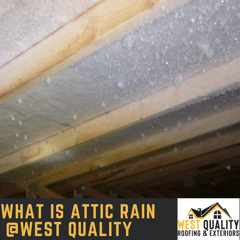Attic rain usually appears as frozen water droplets or frost on the attic ceiling. It results from the accumulation of moisture in the attic, which then freezes during cold temperatures. But since temperatures in the attic tend to fluctuate depending on the weather, the frost could melt and then freeze up again. This puts your attic in a freeze-thaw cycle, which can create problems for your attic or ultimately damage your home.
While attic rain is basically a condensation issue, there are certain factors that can also aggravate the condition of your attic. These include:
1. Gaps in attic walls
These could be in the form of cracks or openings in the walls, ceilings and outlets – which could allow outside temperature to permeate your home and affect the level of moisture in your interior.
2. Poor air sealing
With proper air sealing, you can reduce air leaks and minimize attic rain.
3. Disconnected appliances
Fans, vents, dryers and kitchen hoods that remain plugged in can continue to release humidity into your attic space.
HOW CONDENSATION OCCURS:
Condensation is usually the result of excessive and uncontrolled moisture inside the home, which could be a product of different household activities like bathing and cooking. When moisture gets trapped inside your home, it may collect and form around cold surfaces or gaps in ceilings and windows. Moisture may also accumulate around walls with less insulation or on the underside of the roof decking. If condensation remains unresolved for a long time, this can cause more serious roofing issues that require roof repair or replacement.
SIGNS OF CONDENSATION:
Condensation can take the form of droplets on cold surfaces, commonly near or on your windows. This happens when moisture in the air comes into contact with cold surfaces and when the windows are poorly insulated. Other areas where you can find signs of condensation include bathroom, kitchens and areas around skylights, light fixtures and vents. Your attic could also be vulnerable to condensation, in which case a vapor barrier may be useful. A vapor barrier can handle a small amount of moisture. Just make sure it is in good condition because a damaged vapor barrier can result in melting frost, which could later on appear as brown stains on your ceiling.
Nevertheless, if you are looking for a long-term solution to condensation, your best bet is to improve the insulation and ventilation in your home. Pay close attention to the insulation in your attic. Make sure to also insulate pipes, which often come into contact with warm indoor air.
ROOF LEAKS
Roof leaks can be quite obvious since they result in dripping or running water, usually near ceiling fixtures and lights. They can only occur during rainy weather. So, when you notice dripping water on a hot, sunny day, it’s likely that you are not dealing with a leak. Oftentimes, this could be a condensation issue, but other times these “leaks” may be due to damaged pipes or HVAC units.
Ultimately, your attic should already have a mechanism to deal with the air flow and moisture build up. If it wasn’t included in your property, it may be a symptom of poor design. Check the attic before you invest in a home.
If you’re not sure whether you have a roof leak or some other issue call:
West Quality Roofing and Exteriors ☎️ 403.719.4271




